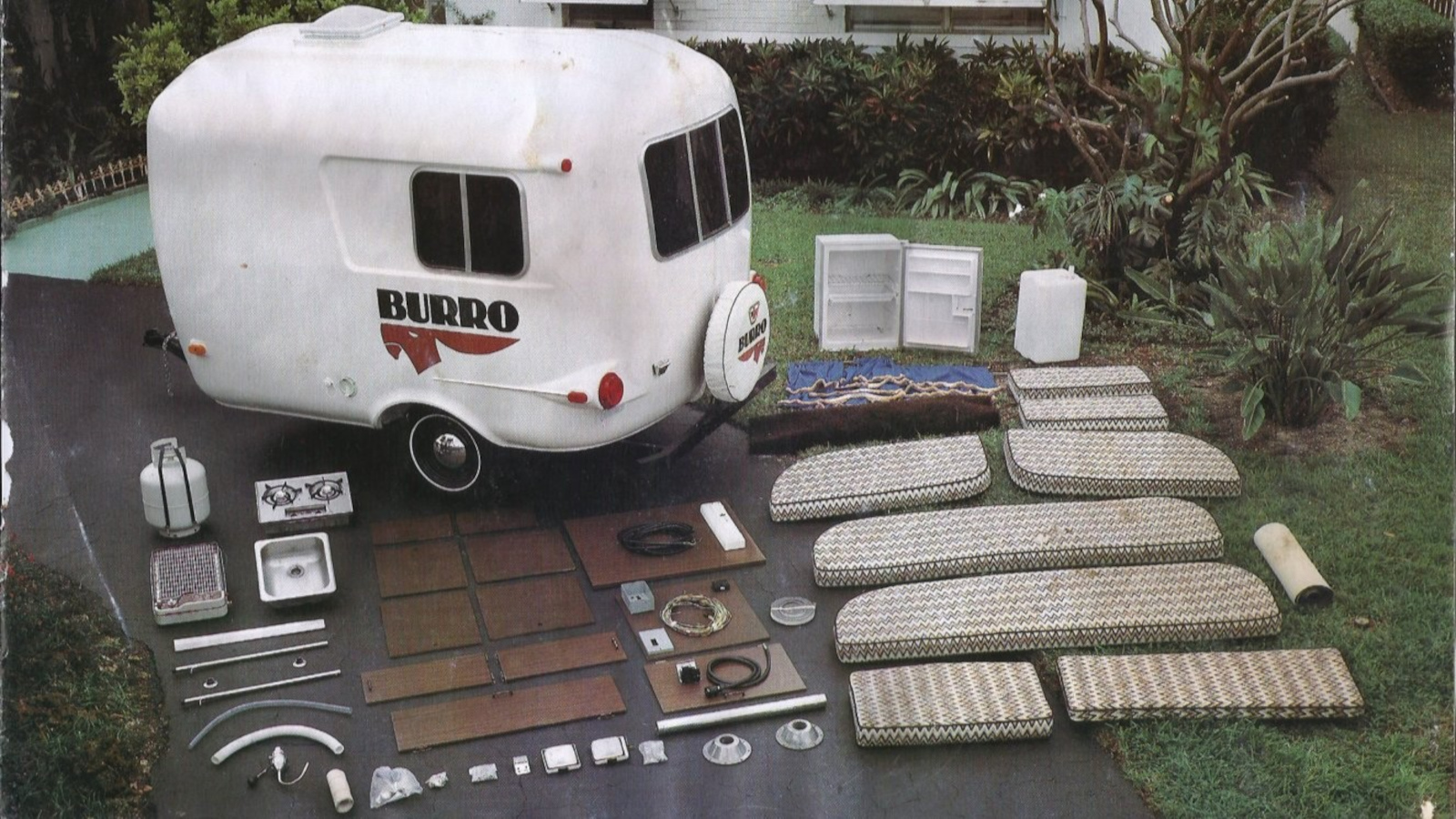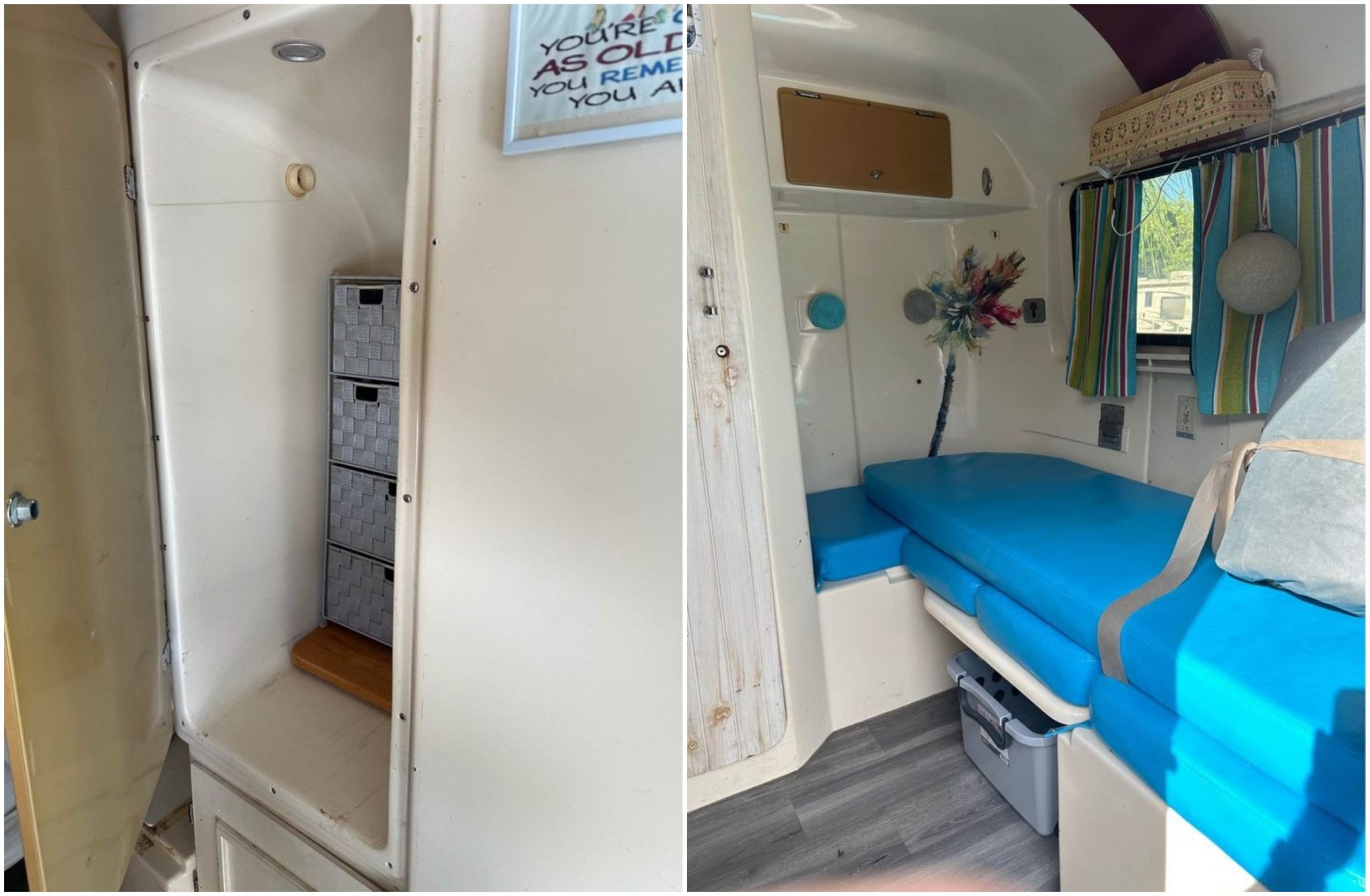
[ad_1]
Every day, I scour the internet for the most special RVs I could find. Many old rigs make me smile, and I’m usually enamored by unique design or offbeat features. Through all of this, I’ve found that there are few campers that make my heart skip a beat quite like the incredible fiberglass U-Haul campers of the 1980s. I just found a unicorn, the true Holy Grail of U-Haul campers. This 1985 U-Haul VT16 is one of just perhaps 56 ever built, and it can be yours.
Before I continue, I should note that my own U-Haul CT13 is still around! Admittedly, I haven’t started restoration work on it, but I have done some preservation work so it’ll stay in “cold storage,” so to speak. The siblings of my little CT13 are highly sought after with fans of vintage campers. U-Haul built fewer than 2,000 of them and the rental giant made them for rental service, so they’re pretty durable. This VT16 is slightly larger and better equipped, and it’s so rare it puts most of our Holy Grail cars to shame.
![]()
From U-Haul’s Wildest Era

Throughout much of the 1900s, Americans discovered a new way to spend their free time. Instead of more traditional vacation ideas, they hit the road, bringing along a living space for them. Camping vehicles evolved with the times, growing from a basic wooden box slapped onto a wagon to elaborate palaces on wheels. The late 1960s and the early 1970s brought on a rise of a different construction material. The fiberglass camper promised lower maintenance, lighter weight, and a distinctive style.
Americans were downsizing in this era thanks to fuel crises, tightening vehicle emissions, and a worsening economy. A lot of Americans no longer owned vehicles that could tow a huge camper, but still wanted to explore this large country. This helped pave the way for fiberglass trailers to become a favorite for some. Meanwhile, U-Haul – the do-it-yourself rental giant – saw an opportunity.

Today, U-Haul is known best for its fleet of durable rental trailers that you cannot buy. U-Haul will also put you behind the wheel of a truck with a 26,000-pound GVWR or allow you to store your stuff in preserved historic buildings all over America. But there was a time when U-Haul was known for more than just moving equipment and storage.
Back in the 1980s, U-Haul was trying its hand at letting Americans rent essentially anything. Watch this commercial below and you’ll see what I mean:
I’ve told this story before, but it’s so silly that it’s worth mentioning again. In the 1980s, you could enter a U-Haul rental store and walk out with a belt sander, an ATV, a Jet Ski, a VHS player, a tractor, and a Winnebago if you wanted to. U-Haul even had a humorous spy thriller-themed ad where a discount James Bond-type fella suited up in U-Haul’s colors escapes from some bad guys first in a truck, then a three-wheeler, and finally a Jet Ski before arriving to a woman in bed.
The best part is that all of this equipment had U-Haul branding and colors all over it. To this day, I wonder if any of the U-Haul ATVs and Jet Skis survived.
When it came to camping equipment, U-Haul offered a choice of motorhomes or two different towables. The motorhomes came from the likes of Winnebago, but when it came time for U-Haul to offer rental towable campers, it ran into a problem.
U-Haul Builds Its Own Campers

For decades, fiberglass camper enthusiasts have given us best guesses and assumptions about how U-Haul’s splendid campers came to be. A long-time popular rumor is that U-Haul nabbed some molds from Burro Inc. and just made minor changes to create the smaller U-Haul CT13 Get-A-Way Camper. This is believable, as Burros and U-Hauls look like they could be siblings! Others have said that U-Haul made a deal with Scamp and U-Hauls were just Scamp models with new stickers and a slightly different layout.
Here’s a Burro for reference. It’s easy to believe U-Haul took Burro’s molds. However, Burro was still in production at this time, so that would have been unlikely.

Back in 2021, I decided to answer this question once and for all by reaching out to the U-Haul Media Relations team. It was a shot in the dark, but maybe someone there knew how the campers were built. As luck would have it, I was able to speak to the last engineer still employed at U-Haul who still had knowledge of the camper trailer program.
As the engineer told me, when U-Haul was executing its plan to rent out lightweight campers, the company’s engineers examined the campers then on the market. Apparently, the engineers liked the features they saw but weren’t convinced existing units could survive years of abuse as rental trailers. To solve this, U-Haul decided to build its own ultra-durable camper.

The engineer told me that U-Haul’s design process involved buying some of the most popular fiberglass trailers on the market, and then hauling them into U-Haul’s warehouse. Those trailers included a Burro, a Scamp, and other then-popular brands. The engineers were then told to examine each trailer for its strengths and weaknesses.
Engineers would then create their own trailers with their favorite strengths, without the downfalls of other units, and backed by U-Haul’s proprietary frame. Getting into campers apparently fulfilled a dream of U-Haul founder Leonard Samuel Shoen.

The engineer told me that while a U-Haul CT13 and VT16 look similar to offerings from other brands, U-Haul wasn’t using anyone else’s molds. In this case, a CT13 looks like a Burro because the engineers loved the Burro design so much they decided to copy it.
With the designs locked in, U-Haul’s campers were manufactured by U-Haul subsidiary Rec-Vee World, as well as Dayton Trailer Manufacturing Company in Ohio, Youngstown Trailer Manufacturing in Ohio, and potentially a couple of more companies. Despite the might of U-Haul and the large number of manufacturing plants involved, you’d there would be a lot of these campers out there. However, U-Haul produced campers for just two years, 1984 and 1985.

Sadly, while U-Haul did preserve records of the program, including production numbers, the gentleman that I spoke with couldn’t find them. He spent weeks digging through U-Haul’s archives without any luck. The Media Relations team told me the records could have been lost during an office move. The best guess came from U-Haul CEO Joe Shoen, who loves the campers so much he has his own CT13. He said that there are less than 2,000 CT13s in the wild. And the VT16 just barely exists with anywhere between 59 and 80 units made. How many of either are left in functional condition is also unknown.
At any rate, U-Haul succeeded in its mission. The CT13 Get-A-Way Camper (also sometimes just called Camper in graphics) and the VT16 Vacation Traveler were trailers constructed out of double hulls of thick fiberglass and rode on U-Haul’s strong proprietary frame. Like U-Haul’s cargo trailers, the campers were designed around the idea of being easy to use, easy to hitch up, and easy to tow. My CT13 is one of the easiest trailers to hook up with a tongue light enough to handle by hand and a confidence-inspiring hand-wheel coupler lock.
Inside, you got everything you needed and nothing you didn’t. CT13s came with a front seating area that turned into a bunk bed, a dinette that also turned into a bed, and a central area consisting of a basic kitchen with an icebox and a manual pump sink. On the other side of the trailer is a somewhat spacious wardrobe. Basic features included rear stabilizer jacks, a swamp cooler, a furnace, a solar panel, and a stove. The CT13, which featured a 10-foot box, a 13-foot total length, and a weight of about 1,100 pounds, was designed to be the camper your family rented for a short weekend getaway.

If you wanted to camp out a little longer and could find one to rent, there was the VT16 Vacation Traveler. As the name would suggest, this camper added three feet of length. More than that, VT16s have an air-conditioner instead of a swamp cooler, a refrigerator instead of an icebox, and the extra space allowed for a small bathroom consisting of a sink and a toilet. The VT16 clocked in at about 1,850 pounds empty, which still allowed a variety of vehicles to tow it.
This 1985 U-Haul VT16

Normally, a U-Haul trailer’s life ends when the company is done renting it. U-Haul destroys most of its trailers once their service lives are over. It’s sad because U-Haul builds some of the best trailers money cannot buy. However, the CT13 and VT16 trailers were an exception to the rule. The company rented the trailers until about 1992 when it was decided to pull out of camper rentals. Instead of just scrapping the campers, U-Haul etched “Not” in front of “Property Of U-Haul” on the trailers’ tongues and then sold them to the public.
That brings us to today’s VT16. Most of the photos in this piece are of the trailer for sale today. It’s not in 100 percent original condition, but it presents in great shape. Besides, if you’re going to wait for an original you may never find one.


On the exterior, obvious changes include custom graphics, a new porch light, a removed window on the left side, a replaced rear window, and new lights. This trailer also still rides on its factory steel tube frame While these trailers were strong, their frames are known for rotting out. There is some rough rust present on this unit’s frame, but it could be fixed.
The interior has been given an update as well. From the factory, this trailer would have had pretty drab gray fabrics and U-Haul logos over every conceivable solid surface. While the bathroom has a new door and the cushions are now blue, you can still see some original U-Haul cabinet doors. The bathroom appears to have its original sink, but a newer cassette toilet. Also different is where the kitchen used to be. Now it’s just one large butcher block countertop with a newer refrigerator underneath. The lack of a propane bottle up front suggests any propane features no longer work.

So, it’s not a perfect trailer, but it’s still a good version of an absurdly rare unit. I would definitely want to restore the kitchen and try to find the probably unobtanium left window. Honestly, just seeing one of these for sale is almost breaking my brain. Usually, when a VT16 shows up for sale it disappears before I can even let out an “Oh my gosh” and dream about owning it.
Roy, the seller out of Sebastian, Florida, is asking $10,000 for the unit. There was a time when you could get an original U-Haul in good condition for $6,000, but those days are long over. Now, a clean original sells for $15,000 or sometimes more. This one seems like it’s priced within a fair range. I never wanted a loose $10,000 in my pocket more than I do right now. So, one of you has to become the new caretaker of this awesome piece of history.

(Images: Roy Munson, unless otherwise noted.)
Support our mission of championing car culture by becoming an Official Autopian Member.

[ad_2]